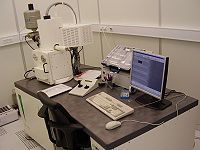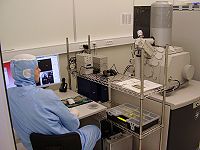Specific Process Knowledge/Characterization/SEM: Scanning Electron Microscopy
The Scanning Electron Microscopes at Danchip

At the moment we have three SEM's. Together they cover a wide range of needs in the cleanroom: From the fast in-process verification of different process parameters such as etch rates, step coverages or lift-off quality to the ultra high resolution images on any type of sample intended for publication.
The SEM that will cover most users needs is the Leo SEM. It is a very reliable and rugged instrument that provides high quality images of most samples. Due to its robustness new users only need a mandatory two hour training session before they are free to use it by themselves. It is a standard high vacuum instrument equipped with a field emission gun, 3 high vacuum electron detectors (Se2, Inlens and RBSD) and a Röntec EDX system. You can obtain excellent images on a large variety of materials such as semiconductors, semiconductor oxides or nitrides, metals, thin films and some polymers.

The popularity and need for the Leo SEM is however such that a 'maximum 2 hour per session' policy is necessary - so it may be difficult to get access to it. The less advanced Jeol SEM offers a great alternative for many types of SEM needs. If you have to check the result of an etch process, a lift-off etc. before you proceed with the process sequence, the Jeol SEM is a much better choice. It is simple, faster to use, has a very low sample exchange time and is by far more accessible than the Leo SEM. There is a very good chance that it is free when you need it. On heavily charging polymers such as SU-8 it even does a better job. To use it, a 1-2 hour training session is necessary.

The new FEI SEM is our most advanced SEM. It has been acquired to cope with the growing need for polymer and e-beam related imaging. It is a state-of-the-art microscope with two vacuum modes (High Vacuum and Low Vacuum) and 7 different detectors, offering unsurpassed resolution on any type of sample or material. This great performance, however, requires a skilled operator that knows how to achieve it. Also, we have learned that the high degree of sophistication and the great number of detectors make it much less robust compared to the two other SEM's. It is therefore intended to be a superuser instrument where a fewer number of users will be trained.
| SEM - FEI | SEM - Leo | SEM - Jeol | |
|---|---|---|---|
| Model | FEI Nova 600 NanoSEM | Leo 1550 SEM | Jeol JSM 5500 LV SEM |
| Electron emitter type | FEG (Field Emission Gun) | FEG (Field Emission Gun) | Tungsten filament |
| EDX analysis | Oxford Inca system | Röntec system | Not available |
| Vacuum modes | High vacuum (>2*10mbar) and Low vacuum (0.1-1.9 mbar) | High vacuum (>2*10mbar) | High vacuum and Low vacuum |
| Substrate size | Up to 6" wafer with full view | Up to 6" wafer with 4" full view | Up to 4" wafer with full view |
| Additional equipment | Kleindiek micromanipulator with Capres 4 point probe | ||
| Best obtainable lateral resolution (strongly dependent on user skills and sample type) | Down to 1-2 nm | Down to 10 nm | Down to 20-30 nm |
| General availability | Good | Poor | Excellent |
| Ease of use | A sophisticated user interface with many features and many different detectors: Complicated | A simple user interface with joystick and a limited number of detectors: Relatively simple | A simple user interface with joystick with one detector: Very simple |
| Best usage | High resolution imaging of any sample | High resolution imaging of any non-polymer sample | Fast in-process imaging |
